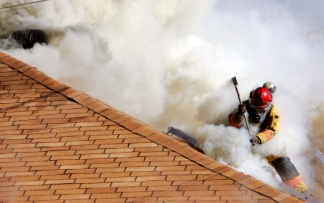Comparing Roofs' Fire Resistance

When it comes to fire, a building's roof is the most vulnerable part of a structure, since burning embers can be blown onto the roof well before a fire reaches the immediate area. Building codes in fire-prone areas often require fireproof or fire-resistant materials to be used on the roof. A fire-resistant or fireproof roof gives the entire structure a better chance to survive a fire.
Shingles are categorized into classes that identify their fire resistance. Class A roofing materials are the most fire-resistant; classes B and C denote progressively less fire-resistant qualities. Generally, most fiberglass shingles have Class A fire ratings, and most organic shingles, such as treated wood shingles, have class C ratings.
Asphalt Shingles
Class A asphalt shingles can withstand a fire burning through the wooden structural components for up to two hours. Because asphalt shingles are relatively inexpensive, they are the most common roofing material, especially in areas where fire isn't an ever-present danger. In fire-prone areas, other fireproof or fire-resistant materials are superior to asphalt shingles.
Concrete and Clay Tiles
Concrete is used more often in industrial and commercial construction rather than residential. For residential buildings, concrete or clay tiles are recommended fireproof, durable roofing materials. Often used for Spanish, Southwest, and Mission architecture, the concrete or clay rounded tiles are heavy in weight and require additional structural support.
Slate
Slate is another heavy roofing material that offers the dual advantages of fire resistance and natural beauty. While nearly indestructible, it tends to be expensive and requires skilled contractors to install it. Due to the weight of slate, a qualified contractor or engineer will need to evaluate the load-bearing capability of the existing structure prior to a slate roof installation. Additional support beams or braces may be required to support the weight of this material.
Metal
Metal roofing is available in the form of zinc, copper, steel, stainless steel, and other alloys. Particularly useful in salty, damp coastal areas, most metals are non-corrosive, as well as being algae-, mildew-, and fire-resistant. Lightweight metal is also suitable for roofs with a steep slope where heavy materials such as slate and tile are impractical or dangerous. Metal sheets and shingles can be fashioned to resemble cedar shake and other roofing materials, but without the fire hazard.
Some builders add products such as Kynar. This insulating metal roof product is resistant to fire, corrosion, abrasion, moisture, and UV rays.
Additional Fire Protection Methods for Roofs
- According to the National Roofing Contractors Association, homeowners should keep tree branches trimmed and away from the roof. Not only do branches scratch and damage roofing materials, if they catch fire, they can ignite the nearby house.
- Use only roof vent covers manufactured of materials that will not readily burn or melt.
- Have a professional roofer inspect your roof regularly. Clear off flammable debris such as pine needles or bird nests. Any missing or damaged shingles – or roof cracks – should be replaced or repaired promptly to keep embers from getting into your home in the event of a nearby fire.
Since the roof is a structure's most vulnerable area, a fireproof or fire-resistant roof is particularly important in areas at high risk of fires. By carefully choosing the roofing materials and properly maintaining their roof, property owners can prevent wind-borne embers from damaging or destroying the property.
This article was updated November 9, 2017.
Looking for a Pro? Call us (866) 441-6648

Roofing Average Costs
Roofers Experiences

Shingle Replacement Stops My Roof Leak Before A Severe Rainstorm

My Roof Replacement Was Simply Outstanding



